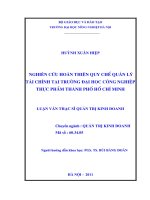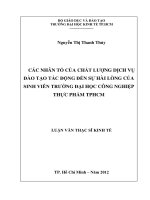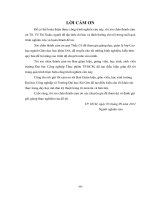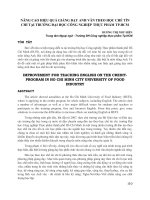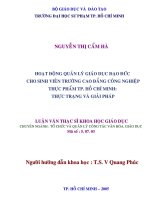Vocabulary English of vocabulary music - Trường Đại học Công nghiệp Thực phẩm Tp. Hồ Chí Minh
Bạn đang xem bản rút gọn của tài liệu. Xem và tải ngay bản đầy đủ của tài liệu tại đây (400.92 KB, 20 trang )
<span class='text_page_counter'>(1)</span><div class='page_container' data-page=1></div>
<span class='text_page_counter'>(2)</span><div class='page_container' data-page=2>
◆ <b>Visual Arts and Artists</b> ◆ <b>Composers and Compositions</b>
◆ <b>Folk Songs and Folk Art</b> ◆ <b>Elements of a Masterpiece</b>
<b>VOCABULARY</b>
<b>MUSIC, ART, AND</b>
<b>LITERATURE</b>
<b>WORDS</b>
<b>VOCABULARY</b>
in context
<b>VOCABULARY</b>
</div>
<span class='text_page_counter'>(3)</span><div class='page_container' data-page=3>
Development and Production: Laurel Associates, Inc.
Cover Design: Elisa Ligon
Interior Illustrations: Katherine Urrutia, Debra A. LaPalm, C. S. Arts
Copyright © 2002 by Saddleback Educational Publishing. All rights reserved.
No part of this book may be reproduced in any form or by any means, electronic
or mechanical, including photocopying, recording, or by any information storage
and retrieval system, without the written permission of the publisher.
ISBN 1-56254-398-9
Printed in the United States of America
07 06 05 04 03 9 8 7 6 5 4 3 2 1
Three Watson
Irvine, CA 92618-2767
E-Mail:
Website: www.sdlback.com
E
VERYDAY
L
IVING
W
ORDS
H
ISTORY
AND
G
EOGRAPHY
W
ORDS
M
EDIA
AND
M
ARKETPLACE
W
ORDS
M
USIC
, A
RT
,
AND
L
ITERATURE
W
ORDS
S
CIENCE
AND
T
ECHNOLOGY
W
ORDS
W
ORKPLACE
AND
C
AREER
W
ORDS
</div>
<span class='text_page_counter'>(4)</span><div class='page_container' data-page=4>
▼
<b>Introduction</b>
...
4UNIT 1
<b>Preview</b> ... 5<b>LESSON</b>
<b>1</b>
<b>Unit 1 Glossary</b> ... 6<b>2</b>
Art That Tricksthe Eye ... 9
<b>3</b>
Ludwig Van Beethoven:The Moody Genius ... 12
<b>4</b>
Edgar Allan Poe and“The Raven” ... 15
<b>5</b>
What Is a “Masterpiece”? .. 18<b>6</b>
Shakespeare’s Theater ... 21<b>7</b>
Music in the News:The Rock and Roll
Hall of Fame, 2001 ... 24
▼ <b>Unit 1 Review</b> ... 27
UNIT 2
<b>Preview</b> ... 30<b>LESSON</b>
<b>1</b>
<b>Unit 2 Glossary</b> ... 31<b>2</b>
Greek Mythology:Pandora’s Box ... 34
<b>3</b>
Woody Guthrie:Songs of America ... 37
<b>4</b>
Pen Names ... 40<b>5</b>
Colossal Creations ... 43<b>6</b>
<i>Mona Lisa</i> ... 46<b>7</b>
Young Artists inthe News ... 49
▼ <b>Unit 2 Review</b> ... 52
<b>CONTENTS</b>
UNIT 3
<b>Preview</b> ... 55<b>LESSON</b>
<b>1</b>
<b>Unit 3 Glossary</b> ... 56<b>2</b>
The Orchestra ... 59<b>3</b>
Georgia O’Keeffe:A New View ... 62
<b>4</b>
Introducing Pablo Picasso .. 65<b>5</b>
Traditions in Music:The Work Song ... 68
<b>6</b>
Dickens BringsCharacters to Life ... 71
<b>7</b>
In the News:Action-Packed Art ... 74
▼ <b>Unit 3 Review</b> ... 77
UNIT 4
<b>Preview</b> ... 80<b>LESSON</b>
<b>1</b>
<b>Unit 4 Glossary</b> ... 81<b>2</b>
The First Haiku ... 84<b>3</b>
The Artist’s Sketchbook .... 87<b>4</b>
Verdi’s <i>Aida</i> ... 90<b>5</b>
The Art Museum: WorkersBehind the Scenes ... 93
<b>6</b>
A Question-Mark Story ... 96<b>7</b>
In the News: Children’sArt World Loses Two of
Its Greats ... 99
▼ <b>Unit 4 Review</b> ... 102
▼
<b>End-of-Book Test</b>
...
105</div>
<span class='text_page_counter'>(5)</span><div class='page_container' data-page=5>
Welcome to VOCABULARY IN CONTEXT!
A well-developed vocabulary pays off in many important
ways. Better-than-average “word power” makes it easier to
understand everything you read and hear—from textbook
assignments to TV news reports or instructions on how to repair
a bicycle. And word power obviously increases your effectiveness
as a communicator. Think about it: <i>As far as other people are</i>
<i>concerned, your ideas are only as convincing as the words you</i>
<i>use to express them.</i> In other words, the vocabulary you use when
you speak or write always significantly adds or detracts from
what you have to say.
VOCABULARY IN CONTEXT was written especially for <i>you</i>.
The program was designed to enrich your personal “word bank”
with many hundreds of high-frequency and challenging words.
There are six thematic books in the series—Everyday Living,
<b>Workplace and Careers, Science and Technology, Media</b>
<b>and Marketplace, History and Geography, and Music, Art,</b>
<b>and Literature. Each worktext presents topic-related readings</b>
with key terms in context. Follow-up exercises provide a wide
variety of practice activities to help you unlock the meanings of
unfamiliar words. These strategies include the study of
synonyms and antonyms; grammatical word forms; word
roots, prefixes, and suffixes; connotations; and the efficient
use of a dictionary and thesaurus. Thinking skills, such as
drawing conclusions and completing analogies, are included
as reinforcement.
A word of advice: Don’t stop “thinking about words” when
you finish this program. A first-class vocabulary must be
constantly renewed! In order to earn a reputation as a
first-rate communicator, you must incorpofirst-rate the new words you
learn into your everyday speech and writing.
</div>
<span class='text_page_counter'>(6)</span><div class='page_container' data-page=6>
<b>UNIT 1</b>
<b>PREVIEW</b>
Here’s an introduction to some of the vocabulary terms, skills, and concepts you will
study in this unit. Answers are upside down on the bottom of the page.
<b>TRUE OR FALSE?</b>
Write <b>T</b> or <b>F</b> to show whether each statement is <i>true</i> or <i>false</i>.
1. _____ The words <i>famous</i> and <i>unknown</i> are antonyms.
2. _____ The word <i>inductee</i> contains the prefix <i>-ee</i>.
3. _____ The prefix <i>re-</i> means “again.”
4. _____ The Greek root <i>phone</i> means “sound.”
5. _____ <i>Lifetime </i>and <i>artist</i> are both compound words.
6. _____ <i>Musical</i> is the adjective form of the noun <i>music</i>.
7. _____ <i>Narrator</i> and <i>author</i> are synonyms.
8. _____ A <i>playwright</i> is a specific type of <i>author</i>.
<b>SPELLING</b>
Circle the correctly spelled word in each group.
4. theatere theatar theater
5. artust artist ardist
6. poem poum pome
1. playwrite playwright playright
2. musishun musicain musician
3. skulptur sculpture sculphure
ANSWE
RS
:
TRU
E
OR
FALS
E
?
1. T 2. F 3. T 4. T 5. F 6. T 7
. F 8. T
SP
ELLI
NG
: 1. play
wright 2. musician 3. sculpture 4. theater 5. artist 6. poem
</div>
<span class='text_page_counter'>(7)</span><div class='page_container' data-page=7>
<b>GLOSSARY</b>
A <i>glossary</i> is an alphabetical list of unusual or specialized words from a certain
field of knowledge. Following are some important words from the fields of art,
literature, and music.
<b>alliteration</b> the repetition of the same
first sound in a group of words
<b>artist</b> a person who creates works of
art such as drawings, paintings,
sculpture, architecture, music,
literature, drama, and dance
<b>audience</b> people gathered to see and
hear something, especially a play,
lecture, or concert
<b>author</b> a person who writes
something, such as a book or story
<b>composer</b> a person who puts notes
together to create a piece of music
<b>design</b> an arrangement of lines,
shapes, patterns, and colors
<b>musician</b> a person trained or skilled
in music, especially one who plays
an instrument
<b>narrator</b> the person in a story who
tells what happened
<b>orchestra</b> a large group of musicians
playing together
<b>photograph</b> a picture made with a
camera
<b>pianist</b> one who plays the piano
<b>play wright</b> a person who writes
plays; also called a <i>dramatist</i>
<b>poem</b> a piece of writing having
rhythm and, often, rhyme; usually
in a style of language that has more
feeling and description than usual
writing or speech
<b>rhyme</b> words that have the same end
sounds, such as <i>cat </i>and <i>hat</i>
<b>scenery</b> the background structures
used to decorate a stage during a play
<b>symphony</b> a long piece of music
written for an orchestra
<b>theater</b> a place where plays are
performed or movies are shown
<b>VOCABULARY IN CONTEXT</b>
Complete each sentence with a word from the glossary. Use the first letter as a clue.
Other words in the sentence will help you decide which word to add. If you’re still not
sure, check the dictionary definition.
1. In Shakespeare’s day, nobles and commoners alike loved going to
the
t
__________________ to watch plays performed.</div>
<span class='text_page_counter'>(8)</span><div class='page_container' data-page=8>
2. Shakespeare was the English __________________ who wrote
p
<i>Romeo</i><i>and Juliet</i> and <i>Hamlet</i>.
3. The
o
__________________ played a __________________ written by thes
famous
c
__________________, Ludwig von Beethoven.4. In a
p
__________________ the last words of every other line oftenr
__________________.
5. The
a
__________________ painted a picture of the beautiful garden.6. The painting looked nearly as real as a __________________ taken
p
with a camera.
7. The __________________ rose from their seats at the end of the play.
a
<b>HIDDEN WORDS PUZZLE</b>
Find and circle the words in the puzzle. The hidden words may go up, down, across,
backward, or diagonally. Check off each word as you find it.
<b>___ ALLITERATION</b> <b>___ POEM</b>
<b>___ PHOTOGRAPH</b> <b>___ AUTHOR</b>
<b>___ ORCHESTRA</b> <b>___ PIANIST</b>
<b>___ SYMPHONY</b> <b>___ RHYME</b>
<b>___ COMPOSER</b> <b>___ ARTIST</b>
<b>___ MUSICIAN</b> <b>___ DESIGN</b>
<b>___ PLAYWRIGHT</b> <b>___ SCENERY</b>
<b>___ AUDIENCE</b> <b>___ THEATER</b>
<b>___ NARRATOR</b>
</div>
<span class='text_page_counter'>(9)</span><div class='page_container' data-page=9>
<b>WORD ROOTS</b>
The Greek root <i>phone</i> means “sound.” The word <i>telephone</i>, for example, means “a
device for sending and receiving sounds.” Read the list of words containing <i>phone</i>. Then
write a letter to match each word with its meaning. Use a dictionary if you need help.
1. _____ <b>symphony</b>
2. _____ <b>saxophone</b>
3. _____ <b>phonetics</b>
4. _____ <b>phonograph</b>
5. _____ <b>xylophone</b>
a. the study of speech sounds as
they are represented in writing
b. device for playing records
c. wind instrument with a curved
metal body
d. long piece of music written for
an orchestra
e. musical instrument with wooden
or metal bars which, when struck
by a hammer, produce tones
<b>CHANGING WORD FORMS</b>
Add <i>vowels</i> (<i>a, e, i, o, u</i>) to complete a different form of a word from the glossary.
Use context clues for help. The first one has been done for you.
1. Beethoven liked to be alone when he c__m p__s__d music.
2. An __r t__s t__c person uses his or her talents to create beauty.
3. An interior d__s__g n__r helps people decorate the inside of their
homes and other buildings.
4. The first s c__n__ of the play took place in a schoolyard.
5. Beethoven began playing the p__ __n__ when he was a child.
6. “Smile for the camera,” said the p h__t__g r__p h__r.
7. The sweet tones of the slow, beautiful m__s__c created a
romantic mood.
8. A wounded soldier n__r r__t__d the exciting war story.
</div>
<span class='text_page_counter'>(10)</span><div class='page_container' data-page=10>
<b>Lesson 2</b>
<b>Art That Tricks the Eye</b>
Have you ever wondered whether
a picture was a drawing or a
photograph? Some artists deliberately
try to trick the viewer. They try to
make a work of art look like the real
thing! This style of art is called
<i>trompe l’oeil</i>. The name, pronounced
<i>trawmp-LOY,</i> is French. It means “to
trick or fool the eye.”
Artists have used different
techniques to create trompe l’oeil.
Some have sculpted realistic
statues of human beings. Others
have modeled wax fruits that
tempt people to take a bite. Interior
decorators have painted windows
on walls and carpets on floors. An
early example of trompe l’oeil was
found in an ancient Roman ruin. The
floor was covered with mosaic tiles.
The image created on the tiles
<b>WORD SEARCH</b>
1. What eight-letter verb in the reading means
“to have made by shaping clay, wax, or other
materials into statues, figures, or objects”? ____________________
s
2. What six-letter noun means “a picture or
design made by putting together bits of
colored stone, tile, or glass”?
m
____________________appears to be the remains of a great
feast. The artist even created a mouse
in one corner to nibble the crumbs!
This famous mosaic is known as <i>The</i>
<i>Unswept Floor</i>.
If you keep your eyes open,
you’re likely to see examples of
trompe l’oeil. This is a popular,
entertaining art form. Trompe
l’oeil artists—sometimes called
<i>illusionists</i>—enjoy the challenge
of deceiving their viewers. They
create an optical illusion—an effect
so convincing that viewers truly can’t
believe their own eyes!
<b>MUSIC, ART, AND LITERATURE WORDS</b>
<b>UNIT 1</b>
<b>WAX</b>
</div>
<span class='text_page_counter'>(11)</span><div class='page_container' data-page=11>
<b>SUFFIXES</b>
•
Rewrite each <b>boldface</b> word from the reading by adding the correct suffix from the box.<i><b>-ist</b></i><b> = a person who “does” or “is skilled at” something</b>
<i><b>-al</b></i><b> = “of” or “like” something</b>
1. A trompe l’oeil <b>art</b> ____________________ tries to trick viewers.
2. An <b>illusion</b> ____________________ is a person who tries to make
people think they see what is not really true.
3. An <b>optic</b> ____________________ illusion is a trick of the eye.
•
Now write one more word that contains each suffix.<i><b>-ist:</b></i> _________________________ <i> -al:</i><b> </b>_________________________
<b>ANALOGIES</b>
<i>Analogies </i>are statements of relationship. To come up with the missing word, you
must figure out the relationship between the first two words. Complete the analogies
below with words from the box.
<b> ancient</b> <b>deceiving</b> <b>photograph</b> <b>sculpted</b> <b>tempt</b>
1. <i>Paintbrush</i> is to <i>painting</i> as <i>camera</i> is to _________________________.
2. <i>Want</i> is to <i>desire</i> as <i>lure</i> is to _________________________.
3. <i>Drew</i> is to <i>sketched</i> as <i>modeled</i> is to _________________________.
4. <i>Big</i> is to <i>small</i> as <i>modern</i> is to _________________________.
5. <i>Working</i> is to <i>laboring</i> as <i>tricking </i>is to _________________________.
3. What seven-letter adjective means “visual;
having to do with the sense of sight”?
o
____________________4. What eight-letter noun means “an appearance
that makes viewers perceive something in a
false or mistaken way”? ____________________
i
p
s
d
t
</div>
<span class='text_page_counter'>(12)</span><div class='page_container' data-page=12>
<b>SYNONYMS</b>
Complete the puzzle with
words from the reading. Clue
words are <i>synonyms</i> (words
with similar meanings) of
the answer words.
<b>ACROSS</b>
1. favorite
3. method
5. found
7. flawless
<b>DOWN</b>
1. snapshot
2. tricking
4. banquet
6. true
<b>PARTS OF SPEECH</b>
Many words become different parts of speech when they’re used in different contexts.
•
The <b>boldface</b> word in each sentence below is used as a <i>noun</i>. Write new sentencesusing the words as <i>verbs.</i>
1. An early example of trompe l’oeil was discovered in an ancient
Roman <b>ruin</b>.
_________________________________________________________________
2. It appears to be the <b>remains</b> of a great feast.
_________________________________________________________________
3. Trompe l’oeil artists—sometimes called illusionists—continue to
take on the <b>challenge</b> of deceiving their viewers.
_________________________________________________________________
4. The floor was covered with a <b>design</b> made of mosaic tiles.
_________________________________________________________________
•
The <b>boldface</b> word in the next sentence is used as a <i>verb</i>. Write a new sentenceusing the word as a <i>noun</i>.
5. It means “to trick or <b>fool</b> the eye.”
_________________________________________________________________
P
D
T
F
D
R
P
5
4
3
2
7
1
</div>
<span class='text_page_counter'>(13)</span><div class='page_container' data-page=13>
<b>Lesson 3</b>
In 1774, four-year-old Ludwig van
Beethoven had to stand on the piano
bench to reach the keys. Eventually,
he became known as Germany’s
greatest pianist. Beethoven’s talent
attracted many friends. But he was a
moody genius. If people talked while
he played, he would walk off in a huff.
He was notorious for rude behavior.
Once he got mad at a waiter and
dumped gravy on the man’s head! The
fashionable hairstyle of the times was
neat pigtails, but Beethoven wore his
hair long and wild. He cared nothing
about stylish clothes.
Beethoven scorned company. He
preferred being alone to compose
symphonies. Sometimes he worked for
days without sleep. Beethoven’s most
well-known notes begin his Fifth
Symphony. They are three short beats
followed by one long beat. Some
people think these notes represent
Fate knocking at the door.
What is the worst thing you could
imagine happening to a musician? In
his twenties, Beethoven began to lose
his hearing. He broke piano strings by
pounding hard enough to hear the
notes. The deaf composer became
even more eccentric. When conducting
an orchestra, he’d shout without
realizing it. In his last performance,
Beethoven could not hear the
audience. When someone turned him
around to make him aware of the
applause, Beethoven began to cry.
The great composer died at age 57.
Until the very end, he was a wild,
defiant genius. According to legend,
when a thunderstorm rattled the room,
Beethoven roused himself from his
death bed and shook his fist at the sky.
<b>WORD SEARCH</b>
1. What eight-letter noun from the reading means
“a long piece of music played by a full orchestra”? ___________________
2. What four-letter noun from the reading rhymes
with <i>puff </i>and means “a fit of anger”? ___________________
3. What four-letter adjective from the reading
means “incapable of hearing”? ___________________
<b>Ludwig Van Beethoven: The Moody Genius</b>
<b>MUSIC, ART, AND LITERATURE WORDS</b>
<b>UNIT 1</b>
<b>Symphony No. 5 in C Minor</b>
</div>
<span class='text_page_counter'>(14)</span><div class='page_container' data-page=14>
<b>ANTONYMS</b>
Use the clue words to help you solve
the crossword puzzle. Clue words are
<i>antonyms</i> (words with opposite meanings)
of words in the reading.
<b>ACROSS</b>
4. unknown
5. agreeable
6. never
<b>DOWN</b>
1. outdated
2. idiot
3. welcomed
<b>SYNONYMS</b>
•
Write synonyms by unscrambling the letters to spell a word from the box.<b>conducting</b> <b>eccentric</b> <b>fate</b> <b>roused</b>
1. leading = _____________ <b>(TCUDGICONN)</b> 3. destiny = ______________ <b>(TAEF)</b>
2. odd = __________________ <b>(CENTRECIC)</b> 4. stirred = ____________ <b>(SURDOE)</b>
•
Now complete each sentence with one of the unscrambled words. <b>Boldface</b> cuewords are synonyms of the correct words.
5. When Beethoven was (<b>leading</b>) ____________________ an orchestra,
he would wave his arms wildly.
6. In a cruel twist of (<b>destiny</b>) ____________________, the great
Beethoven became deaf.
7. Beethoven’s habits of dress were very (<b>odd</b>) ____________________.
8. Beethoven’s music (<b>stirred</b>) ____________________ great excitement
and emotion in audiences.
F G
S
N
D
E
6
5
4
3
</div>
<span class='text_page_counter'>(15)</span><div class='page_container' data-page=15>
<b>MULTIPLE-MEANING WORDS</b>
Some words have entirely different meanings when they’re used in different contexts.
Find a word in the reading that matches each pair of definitions below. Write the words
on the lines. Then circle the letter of the definition used in the reading.
1. ____________________ a. a fit of anger (noun)
b. to blow or puff air (verb)
2. ____________________ a. to form by combining (verb)
b. to create or to write (verb)
3. ____________________ a. hits or strikes (verb)
b. units of rhythm in music (noun)
4. ____________________ a. metal devices used to open locks (noun)
b. flat slats that are pressed down to play
certain instruments (noun)
5. ____________________ a. musical tones (noun)
b. written reminders (noun)
6. ____________________ a. a story retold through the years (noun)
b. a description of the details on a map (noun)
<b>ANALOGIES</b>
<i>Analogies </i>are statements of relationship. To come up with the missing word, you
must figure out the relationship between the first two words. Complete the analogies
below with words from the reading. The first one has been done for you.
1. <i>Artist</i> is to <i>painting</i> as _________________________ is to <i>symphony</i>.
2. <i>Live</i> is to <i>die</i> as <i>laugh</i> is to _________________________.
3. <i>Strings</i> are to <i>violin</i> as <i>keys</i> are to _________________________.
4. <i>Blindness</i> is to <i>sight</i> as _________________________ is to <i>hearing.</i>
5. <i>Coaching</i> is to <i>team</i> as _________________________ is to <i>orchestra.</i>
composer
c
d
c
</div>
<span class='text_page_counter'>(16)</span><div class='page_container' data-page=16>
<b>Lesson 4</b>
<b>Edgar Allan Poe and “The Raven”</b>
American author Edgar
Allan Poe was fascinated
with all that is eerie and dark. His
stories and poems are frightening—
yet they are also beautiful. Poe had
a short, tragic life. His writings reflect
his fears of lost love and loneliness.
His young wife, Virginia, did in fact
die early. At her death, Poe was left
broken-hearted.
In 1845, Poe wrote “The Raven.”
In this famous poem, the narrator sits
alone, mourning the death of his lost
love, Lenore. Notice the musical
rhyme as lines in the first verse
describe the gloomy scene:
<i>While I nodded, nearly napping,</i>
<i>suddenly there came a tapping,</i>
<i>As if someone gently rapping,</i>
<i>rapping at my chamber door.</i>
At first the narrator thinks the
rapping might be Lenore returning.
But the next line tells what he actually
sees when he opens the door:
<i>In there stepped a stately raven</i>.
Poe uses a poetic device called
“alliteration”—repeating beginning
word sounds—when describing the
raven as a <i>grim, ungainly, ghastly,</i>
<i>gaunt, </i>and <i>ominousbird</i>. The raven
says just one word: “Nevermore.”
This cruelly reminds the narrator that
he shall never again see Lenore.
The last lines are both sorrowful
and musical. The narrator understands
that he will be haunted by the raven
and by loneliness all of his days.
. . .<i> And the lamplight o’er him</i>
<i>streaming throws the shadow</i>
<i>on the floor;</i>
<i>And my soul from out that</i>
<i>shadow that lies floating on</i>
<i>the floor</i>
<i>Shall be lifted—nevermore!</i>
<b>WORD SEARCH</b>
1. What five-letter adjective in the reading begins
with double letters and describes something
that gives a fearsome, mysterious feeling? ____________________
2. What eight-letter noun in the reading means
“the person who tells what happened”? ____________________
<b>MUSIC, ART, AND LITERATURE WORDS</b>
<b>UNIT 1</b>
</div>
<span class='text_page_counter'>(17)</span><div class='page_container' data-page=17>
3. What five-letter noun in the reading means
“one of the sections of a poem or song”? ____________________
4. What seven-letter adjective in the reading
means “threatening; a bad omen”? ____________________
<b>UNDERSTANDING LITERARY TERMS</b>
In “The Raven,” Poe uses two poetic devices called <i>rhyme</i> and <i>alliteration</i>. Words that
<i>rhyme</i> end in the same sounds (dark, lark, park). <i>Alliteration</i> repeats the same sound
at the beginning of two or more words (slippery slithering snake). Write <b>R</b> for <i>rhyme</i>
or <b>A</b> for <i>alliteration</i> beside each of the following items from the poem.
1. _____ <i>Ah, distinctly I remember, it was in a bleak December . . .</i>
2. _____ <i>. . . dreaming dreams no mortal ever dared to dream before. . .</i>
3. _____ <i>. . . the rare and radiant maiden whom the angels name</i>
<i>Lenore. . .</i>
4. _____ <i>Thus I sat engaged in guessing, but no syllable expressing. . .</i>
5. _____ <i>“Be that word our sign of parting, bird or fiend!” I shrieked,</i>
<i>upstarting. . .</i>
<b>ANALYZING WORDS</b>
1. Find three adjectives in the reading that describe Edgar Allan Poe’s
stories and poems. Write them on the lines.
____________________ ____________________ ____________________
2. What compound word does the visiting
raven repeat? ___________________________
3. Find an adjective in the reading that
describes the narrator’s mood. Write it
on the line. __________________________
4. The poem is about a bird called a <i>raven</i>. If someone
were described as raven-haired, what color
would this person’s hair be? ________________________
</div>
<span class='text_page_counter'>(18)</span><div class='page_container' data-page=18>
<b>SYNONYMS</b>
Use the clue words to help you solve
the crossword puzzle. Clue words
are <i>synonyms</i> (words with a similar
meaning) of words in the reading.
<b>ACROSS</b>
3. scary, alarming
4. said, uttered
5. blackness, dimness
<b>DOWN</b>
1. clumsy, awkward
2. realizes, knows
3. enchanted, interested
<b>ANTONYMS</b>
Draw a line to match each <b>boldface </b>word from the reading with its antonym (word
with an opposite meaning).
1. <b>famous</b> a. happy
2. <b>midnight</b> b. well-fed
3. <b>tragic</b> c. soon
4. <b>gaunt</b> d. noon
5. <b>nevermore</b> e. unknown
<b>WORD FORMS</b>
You can change the form of many words to make different parts of speech. The noun <i>gloom</i>,
for example, can be changed to the adjective <i>gloomy</i>. Change the form of each <b>boldface</b>
word from the reading according to the directions below. The first one has been done for you.
1. <b>loneliness</b> 4. <b>musical</b>
<b>ADJECTIVEFORM:</b> ____________________ <b>NOUNFORM:</b> ______________________
2. <b>sleep</b> 5. <b>beginning</b>
<b>ADJECTIVEFORM:</b> ____________________ <b>VERBFORM:</b>_______________________
3. <b>sorrowful</b> 6. <b>shadow</b>
<b>NOUNFORM:</b>______________________ <b>ADJECTIVEFORM:</b> ____________________
U
U
F
Q T
D
5
4
3
2
1
</div>
<span class='text_page_counter'>(19)</span><div class='page_container' data-page=19>
<b>Lesson 5</b>
<b>What Is a “Masterpiece”?</b>
Some exceptional paintings are
said to be “great” rather than “good.”
These works of art are called
<i>masterpieces</i>. A masterpiece is more
than a picture of something. It also
tells a story and excites strong
emotions in the viewers.
A masterpiece calls on all the
senses. Viewers might smell the sea,
taste a peach, or even feel motion.
In the dreariness of winter, a
masterpiece can transport viewers to
a bright spring. The next time you
view a painting, ask yourself what
senses it awakens.
A masterpiece makes viewers
<i>feel</i> what they <i>see. </i>Ancient cave
paintings of stampeding bison reflect
the terror in the animals’ eyes. They
tell the viewer something about fear.
Loneliness, joy, hope, unhappiness,
and courage—these are some of the
emotions great artists call upon in
creating their masterpieces.
A masterpiece gives clues about
the artist’s world, culture, and
character. By choice of subject, artists
reflect their surroundings and their
state of mind. During his “blue
period,” for example, the 20th
century artist Pablo Picasso painted
the poor people of Paris. The main
color of the works was blue—a color
which often symbolizes sadness. Like
the color, Picasso’s subjects were sad.
During this time in his life, Picasso
himself was poor and unhealthy.
The next time you go to a museum
or look in an art book, take a closer
look at a great painting. By studying
the masterpiece, see what facts about
history or the artist you can discover.
<b>WORD SEARCH</b>
1. What eleven-letter noun in the reading
means “a great work of art”? _______________________
2. What six-letter plural noun in the reading
names a category that includes sight,
hearing, smell, taste, and touch? _______________________
3. What eight-letter plural noun in the
reading names a category that includes
loneliness, joy, fear, and hope? _______________________
<b>MUSIC, ART, AND LITERATURE WORDS</b>
<b>UNIT 1</b>
</div>
<span class='text_page_counter'>(20)</span><div class='page_container' data-page=20>
<b>SYNONYMS</b>
Complete the crossword puzzle
with words from the reading.
Clue words are <i>synonyms</i>
(words with a similar meaning)
of the answer words.
<b>ACROSS</b>
4. bravery, valor
6. feelings
<b>DOWN</b>
1. charging, rushing
2. civilization
3. buffalo
5. observer, onlooker
<b>PREFIXES</b>
•
The prefix <i>un-</i> means “not,” and the prefix <i>trans-</i> means “over or across.” Write a wordfrom the reading that begins with each prefix. Then write a definition of the word.
1. <i>un-</i> = ____________________
<b>DEFINITION:</b> __________________________________________________________
2. <i>trans-</i> = ____________________
<b>DEFINITION:</b> __________________________________________________________
•
Now unscramble the <b>boldface</b> letters to write a word that begins with <i>un-</i> or <i>trans-</i>.The first one has been done for you.
3. The sound was coming from an <b>KONNWNU</b>____________________
source in the attic.
4. Bob said it was a monster, but that idea was <b>LEBNIEVUBAEL</b>
____________________!
5. I didn’t like my drama class, so I asked for a <b>RATFESNR</b>
____________________ to an art class.
6. Professor Sanchez will <b>SLEATNART</b> ____________________ the book
from English into Spanish.
unknown
S
C B
C
P V
E
6
4
3
2
1
</div>
<!--links-->

